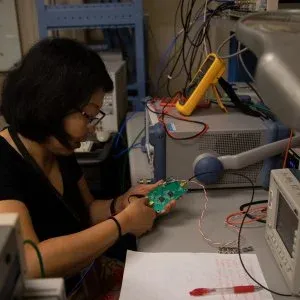Data Management (DM) Department
ADS is responsible for the LCLS experiment data acquisition systems, the online analysis system, and offline software analysis frameworks used by LCLS scientists. The ADS department also plays a key role in the development of systems for LCLS-II, including the Accelerator Timing Controls System and the Experiment Data Acquisition and Data Analysis systems (L2S-I). This department also contributes developments for the LSST camera readout and the DUNE data acquisition systems. These efforts require close integration of software systems with electronics designs to achieve the performance needed for coming projects.
Key Competencies
Data Acquisition Systems
ADS designs hardware, firmware, software for real time data acquisition systems. An example is the Advanced Telecommunication Computing Architecture (ATCA) FPGA module with on-board integrated network switch, ported and bundled with an operating system and real-time kernel. Applications are LHC ATLAS, LSST, HPS, DUNE, nEXO and has applications in other projects where fast processing of packets/data is needed.
Timing Systems
ADS has designed the next generation timing systems for LCLS. These include the event timing system, able to distribute the 1-MHz pulse information required by LCLS-II with nanosecond precision, and the laser timing system able to deliver RF timing with femtosecond accuracy.
Data Reduction
ADS has designed and developed a novel architecture for on-the-fly data reduction called Data Reduction Pipeline or DRP. The DRP hosts a toolbox of techniques intended to reduce the data by an order of magnitude before they are written to disk, from terabytes per second to more manageable level of tens to one hundred gigabytes per second, without affecting the scientific result. This pipeline must reduce the data volume for many rapidly changing experiments, must be scalable up to I/O limitations of detectors, and must be easily configurable to accommodate rapidly changing experimental conditions. The DRP also provides a user-definable fraction of non-reduced events, referred to as prescaled data, to promptly validate that the physics is not being adversely impacted. By applying experiment-specific veto, compression, and feature extraction, the overall throughput and storage requirements for the facility are reduced. This makes it possible to move data to offsite computing facilities such as the National Energy Research Scientific Computing Center (NERSC). Data reduction mitigates storage, networking, and processing requirements and reduces the time required to go from measurement to scientific insight.
Data Management
ADS is responsible for designing, developing and supporting the data management systems of several SLAC experiments. The common aspects of these systems are: distributing the experimental data to different storage resources - where some of the transfers are time critical; data movement across the various layers of the storage hierarchy and over ESnet; handling and storing of metadata, e.g. experimental conditions, screen shots, comments, user defined key value pairs, etc; web based portals that allow users to manage their experiments.


Data Acquisition Systems
TID designs hardware, firmware, software for real time data acquisition systems. Example is an Advanced Telecommunication Computing Architecture (ATCA) FPGA module with on-board integrated network switch, ported and bundled with operating system and real-time kernel. Applications are LHC ATLAS, LSST, HPS, DUNE, nEXO and has applications in other projects where fast processing of packets/data is needed.
